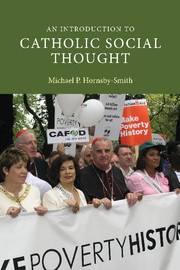Book contents
- Frontmatter
- Contents
- List of tables and figure
- Acknowledgements
- Dedication
- List of abbreviations and acronyms
- PART I SOCIAL REALITY AND SOCIAL ANALYSIS
- PART II THEOLOGICAL RESOURCES
- PART III JUSTICE ISSUES
- 6 Human rights
- 7 The family
- 8 Economic life
- 9 Social exclusion
- 10 Authentic development
- 11 War and peace
- PART IV ACTION RESPONSES
- Appendix: Selected campaigning organizations
- References
- Index
9 - Social exclusion
Published online by Cambridge University Press: 14 January 2010
- Frontmatter
- Contents
- List of tables and figure
- Acknowledgements
- Dedication
- List of abbreviations and acronyms
- PART I SOCIAL REALITY AND SOCIAL ANALYSIS
- PART II THEOLOGICAL RESOURCES
- PART III JUSTICE ISSUES
- 6 Human rights
- 7 The family
- 8 Economic life
- 9 Social exclusion
- 10 Authentic development
- 11 War and peace
- PART IV ACTION RESPONSES
- Appendix: Selected campaigning organizations
- References
- Index
Summary
A MULTIDIMENSIONAL CONCEPT
The fourth main area of injustice is that of social exclusion. The term emerged in France in the 1970s, where it referred to those falling through the net of social protection, and was adopted by the European Commission in 1989. The intention was to address wider issues than poverty. While some people criticize the notion of social exclusion as diverting attention from fundamental economic inequalities of income and wealth and both absolute and relative poverty, it alerts to other forms of marginalization in our society such as political participation and influence. Ruth Lister noted that:
It is a more multidimensional concept than poverty, embracing a variety of ways in which people may be denied full participation in society and full effective rights of citizenship in the civil, political and social spheres … Racism, … sexism, homophobia and disablism, can … operate as mechanisms of exclusion even in the case of those who have adequate material resources.
Four broad dimensions of social exclusion are generally identified:
impoverishment or exclusion from adequate income or resources;
labour market exclusion from paid employment;
service exclusion, for example from education, health and welfare services; and
exclusion from social relationships, including full participation in political processes and decision-making.
People who are poor often have multiple disadvantages of low or inadequate income, wealth, education, qualifications and skills, poor housing and health, all of which effectively exclude them from full participation in the everyday life of society and in its decision-making processes.
- Type
- Chapter
- Information
- An Introduction to Catholic Social Thought , pp. 208 - 240Publisher: Cambridge University PressPrint publication year: 2006

